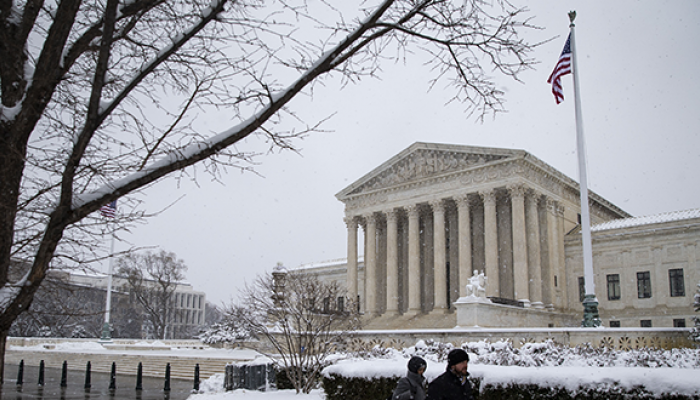Update 1/23: The federal courts’ administrative office has now said it has the funds to operate through January 31 or February 1, but that no further extension beyond that will be possible.
Access to the courts is fundamental to our democracy. But thanks to the federal government shutdown, funding for the federal judiciary could run out on Friday, and what would happen next isn’t certain. What we do know is that a lack of funding for the courts could put the Constitution’s fundamental protections at risk.
The shutdown has left 800,000 government workers furloughed or working without pay, and it has halted or dramatically reduced basic government functions like the maintenance of national parks and the inspection of the national food supply for disease.
Meanwhile, the federal courts, another vital facet of our democracy, have tried to maintain operations at a normal scale using reserve funds. But limits on those funds have already resulted in delayed cases, shortened operating hours, and even the shuttering of the D.C. Superior Court’s Marriage Bureau. It’s not clear what will happen to the courts’ core functions when those funds are exhausted.
For the federal courts, a funding lapse would be uncharted territory
The shutdown began on December 22 after the president refused to sign spending legislation unless it included $5 billion to fund a border wall. On January 12, the shutdown became the longest in U.S. history.
Since the shutdown started, the judiciary has continued paid operations by using reserve funds, which include money from court-related fees. The reserve funds were originally set to expire on January 11, but additional funds were later found to sustain paid operations through January 18, then through January 25.
But the federal courts would be heading into uncharted territory if the reserve funds run out. The courts have said that if that happens, they will “operate under the terms of the Anti-Deficiency Act,” which allows “essential work” to continue during a lapse in appropriations. Each court would determine for itself the staff necessary to “support its mission critical work.” In other words, the Supreme Court and each circuit court, district court and bankruptcy court has a lot of discretion to determine which employees count as “essential” or “non-essential.” So, the courts could end up acting very differently.
There is no historical precedent to help predict what will actually happen if the shutdown continues after the existing funds expire — previous government shutdowns ended before courts exhausted their reserve funds. The courts’ ability to continue operating will depend on many employees, such as clerks, court reporters, interpreters, and administrative officials, working without pay. Other entities that the courts rely on, such as U.S. Marshals, could also be affected. It is also unclear whether jurors will continue to show up at the courts based only on promises that they will be paid at some time in the future. And there’s also the issue that contractors who support courthouse operations may stop getting paid, meaning that some courthouses will no longer be able to be open.
In Illinois, a federal judge has said that the court may run out of money to pay jurors and employees — and place a moratorium on civil trials — if the shutdown continues past early February.
A court funding lapse also risks reverberating throughout the justice system. For example, shortly before the shutdown began, Trump signed the First Step Act, a bipartisan criminal justice reform bill that, among other things, made it easier for prison inmates who are terminally ill to win their release. But that process requires timely action in the court system. In the event of a funding lapse, the courts may be unequipped to handle compassionate release requests.
The shutdown is already having an effect on the courts
Even with reserve funds still in operation, the courts are already feeling the effects of the shutdown. A lack of funding for government attorneys is stymieing courts’ efforts to operate normally. Judges in several districts have issued blanket orders delaying all civil cases in which the United States is involved. The government also obtained a delay in an ongoing lawsuit challenging the Trump administration’s treatment of asylum seekers, while courts have rejected requests to postpone cases related to the proposed citizenship question on the upcoming census.
In addition, the shutdown has already crippled immigration courts, which are housed under the Justice Department rather than the judiciary. The Justice Department has furloughed three-fourths of immigration judges since December 26. Consequently, thousands of cases have been postponed on the court’s active docket, which already had a backlog of more than 800,000 cases even before the shutdown. Most of these cases involve people who have been released from custody or have never been in custody, and many of whom have waited years for their court date.
We need a scenario map for future lapses in funding
We can only speculate about what will actually happen if the shutdown continues and the courts use up all of their reserve funds. But if shutdowns become more common, we may need more formal processes that would help the federal courts respond to lapses in funding and the various scenarios that could ensue.
(Image: Al Drago/Getty)





